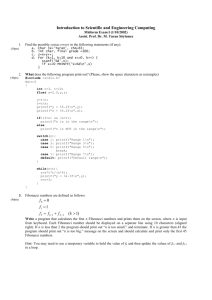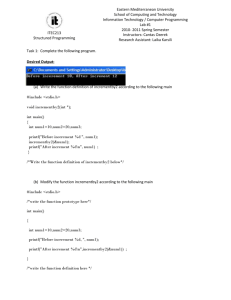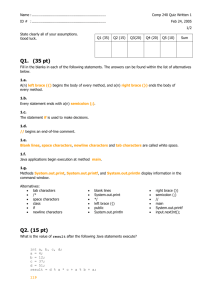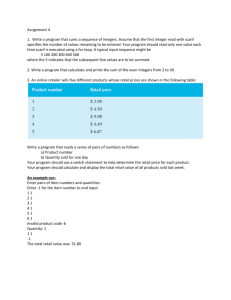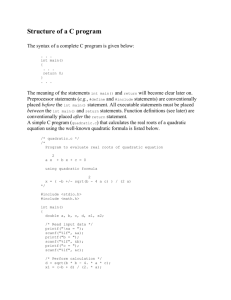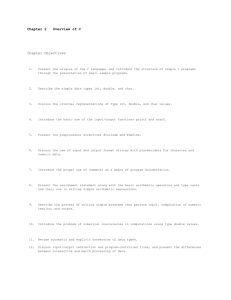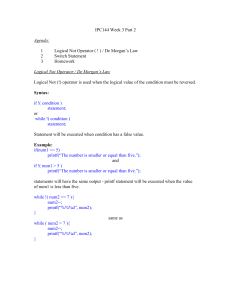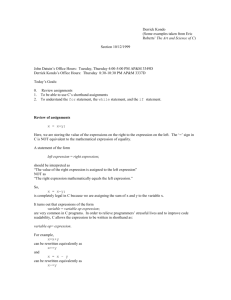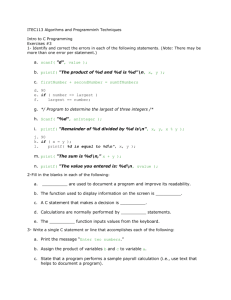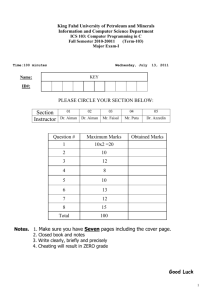ICS 102 - Introduction to Computing
advertisement
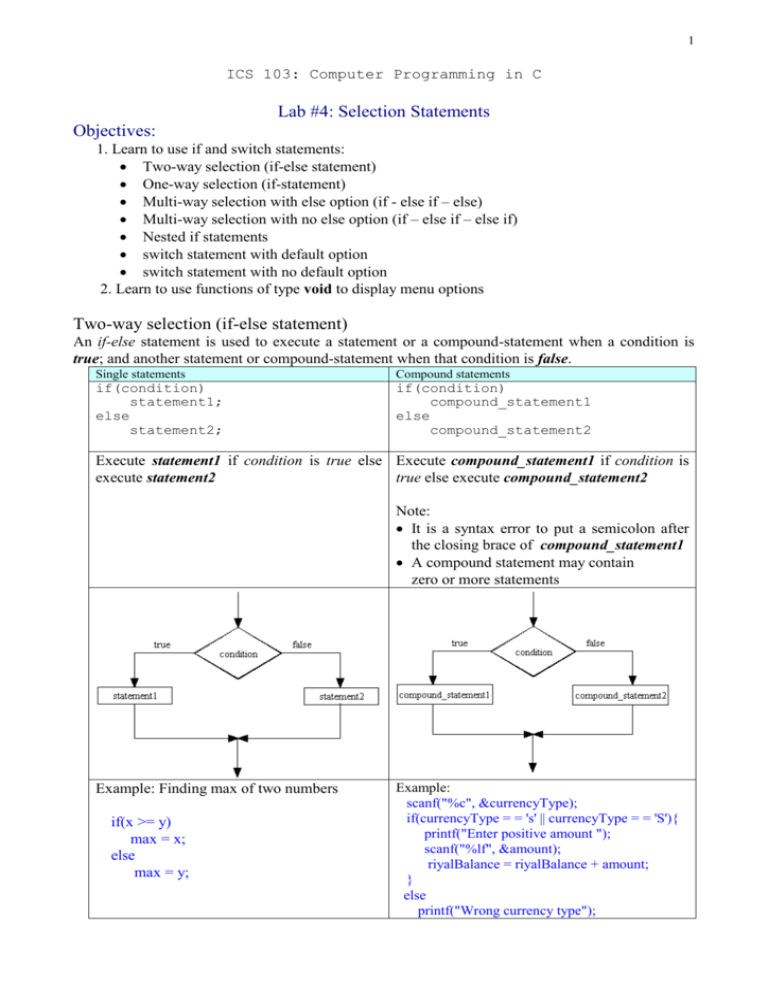
1
ICS 103: Computer Programming in C
Lab #4: Selection Statements
Objectives:
1. Learn to use if and switch statements:
Two-way selection (if-else statement)
One-way selection (if-statement)
Multi-way selection with else option (if - else if – else)
Multi-way selection with no else option (if – else if – else if)
Nested if statements
switch statement with default option
switch statement with no default option
2. Learn to use functions of type void to display menu options
Two-way selection (if-else statement)
An if-else statement is used to execute a statement or a compound-statement when a condition is
true; and another statement or compound-statement when that condition is false.
Single statements
Compound statements
if(condition)
statement1;
else
statement2;
if(condition)
compound_statement1
else
compound_statement2
Execute statement1 if condition is true else Execute compound_statement1 if condition is
execute statement2
true else execute compound_statement2
Note:
It is a syntax error to put a semicolon after
the closing brace of compound_statement1
A compound statement may contain
zero or more statements
Example: Finding max of two numbers
if(x >= y)
max = x;
else
max = y;
Example:
scanf("%c", &currencyType);
if(currencyType = = 's' || currencyType = = 'S'){
printf("Enter positive amount ");
scanf("%lf", &amount);
riyalBalance = riyalBalance + amount;
}
else
printf("Wrong currency type");
2
One-way selection (if-statement)
Used to execute a statement or a compound_statement when a condition is true.
Single statements
Compound statements
if(condition)
statement1;
if(condition)
compound_statement1
Execute statement1 if condition is true
Execute compound_statement1 if condition is
true
printf(“Enter a number: “);
scanf(“%lf”, &num);
if (num > 0)
printf(“The square root is %lf”, sqrt(num));
printf(“Enter a number: “);
scanf(“%lf”, &num);
if (num > 0) {
printf(“The square root is %lf”, sqrt(num));
printf(“The natural logarithm is %lf”, log(num));
}
Example: Finding max of three numbers
max = num1;
if(num2 > max)
max = num2;
Example:
scanf("%c", &currencyType);
if(currencyType == 's' || currencyType == 'S')
{
printf("Enter positive amount ");
scanf("%lf", &amount);
riyalBalance = riyalBalance + amount;
}
if(num3 > max)
max = num3;
Multi-way selection with an else option (if- else if - else statement)
Used to execute the first statement or the first compound_statement whose corresponding
condition is true. The statement in the else part is executed if each condition is false.
Single statements
Compound statements
if(condition1)
statement1;
else if(condition2)
statement2;
else if(condition3)
statement3;
.
.
.
else if(conditionM)
statementM;
else
statementN;
if(condition1)
compound_statement1
else if(condition2)
compound_statement2
else if(condition3)
compound_statement3
.
.
.
else if(conditionM)
compound_statementM
else
compound_StatementN
3
Note: There may be one or more else if
branches
Note:
There may be one or more else if branches.
It is a syntax error to put a semicolon
after the closing brace of a compound
statement in an if branch.
int validGrade = 1;
// set validGrade to true
double grade;
printf("Enter grade");
scanf("%lf", &grade);
if(grade < 0.0 || grade > 100.0)
validGrade = 0;
// set validGrade to false
else if(grade >= 85.0)
letterGrade = 'A';
else if(grade >= 75.0)
letterGrade = 'B';
else if(grade >= 65.0)
letterGrade = 'C';
else if(grade >= 45.0)
letterGrade = 'D';
else
letterGrade = 'F';
if(validGrade)
printf("The letter grade is %c", letterGrade);
else
printf("Error: Invalid grade");
4
Multi-way selection without an else option (if - else if - else if statement)
Used to execute the first statement or compound_statement whose corresponding condition is
true. No if-branch is executed if each condition is false.
Single statements
Compound statements
if(condition1)
statement1;
else if(condition2)
statement2;
else if(condition3)
statement3;
.
.
.
else if(conditionM)
statementM;
else if(conditionN)
statementN;
if(condition1)
compound_statement1
else if(condition2)
compound_statement2
else if(condition3)
compound_statement3
.
.
.
else if(conditionM)
compound_statementM
else if(conditionN)
compound_StatementN
Note: There may be one or more else if
branches
Note:
There may be one or more else if branches.
It is a syntax error to put a semicolon
after the closing brace of a compound
statement in an if branch (except the last
branch).
5
Example:
if(octaneNumber < 91)
printf("Do not use this gasoline");
else if(octaneNumber < 95)
printf("You may use this gasoline");
Nested if statements
The compound statement in an if-branch or an else-branch of an if-statement may contain one or
more of any type of if-statement discussed above.
Example:
if(grade < 0.0 || grade > 100.0)
printf("Error: Invalid grade");
else{
if(grade >= 85.0)
letterGrade = 'A';
else if(grade >= 75.0)
letterGrade = 'B';
else if(grade >= 65.0)
letterGrade = 'C';
else if(grade >= 45.0)
letterGrade = 'D';
else
letterGrade = 'F';
printf("The letter grade is %c", letterGrade);
}
Nested if structures can be complicated:
if(condition1){
statement1;
if(condition2)
statement2;
else
statement3;
statement4;
}
else{
if(condition3)
compound_statementA
else if(condition4)
compound_statementB
else
compound_StatementC
compound_StatementD
}
6
Note: In a nested if statement, the last else is associated with the closest unpaired if, unless braces
are used to alter the default pairing:
Example:
if(hours < 9)
if(distance > 500)
printf("Type 01");
else
printf("Type 02");
is equivalent to:
if(hours < 9){
if(distance > 500)
printf("Type 01");
else
printf("Type 02");
}
Switch statement
The if- else if - else statement is used in programming situations where one set of statements must
be selected from many possible alternatives. The switch statement provides an alternative to this
statement for cases that compare the value of an int or char expression to a specific int or char
constant.
The general form of the switch statement is:
switch(int or char expression){
case constant1: statementList1;
break;
case constant2: statementList2;
break;
.
.
.
case constantM: statementListM;
break;
default:
statementListN;
}
Note:
The case constants must be distinct int or char constants; otherwise there is a syntax error.
A statementList may contain zero or more semi-colon separated statements. It is not
necessary for statementList to be a compound-statement.
The default label together with its statementList may be missing.
The break statement following a statementList may be missing.
The int or char expression is evaluated and then the statementList of the case value that
equals to the expression is executed. If there is a break statement, control passes to the
statement after the switch; otherwise, the following statementLists are executed until a
break statement is encountered, control then passes to the statement after the switch
statement.
If expression is not equal to any case value, the statementList for the default label is
executed, control then passes to the statement after the switch statement. If expression is not
7
equal to any case value and there is no default label, control passes to the statement after the
switch without executing any switch statementList.
switch example01: display the name of a digit:
int digit;
printf("Enter an integer digit:\n");
scanf("%d", &digit);
switch(digit){
case 0:
printf("zero");
break;
case 1:
printf("one");
break;
case 2:
printf("two");
break;
case 3:
printf("three");
break;
case 4:
printf("four");
break;
case 5:
printf("five");
break;
case 6:
printf("six");
break;
case 7:
printf("seven");
break;
case 8:
printf("eight");
break;
case 9:
printf("nine");
break;
default:
printf("Error: Invalid digit");
}
switch example02: classify a character
char c1;
printf("Enter an English alphabet\n");
scanf("%c", &c1);
if(c1 >= 'a' && c1 <= 'z' || c1 >= 'A' && c1 <= 'Z'){
switch(c1){
case 'a':
case 'A':
case 'e':
case 'E':
case 'i':
case 'I':
case 'o':
case 'O':
case 'u':
case 'U': printf("You entered a vowel\n");
break;
default: printf("You entered a consonant\n");
}
}else
printf("You entered a non-English alphabet\n");
8
switch example03: Perform arithmetic operation on two integers
int num1, num2, result;
char operator;
printf("Enter two numbers and the operator\n");
scanf("%d %d %c", &num1, &num2, &operator);
switch(operator){
case '+': result = num1 + num2;
printf("%d + %d = %d\n", num1, num2, result);
break;
case '-': result = num1 - num2;
printf("%d - %d = %d\n", num1, num2, result);
break;
case '*': result = num1 * num2;
printf("%d * %d = %d\n", num1, num2, result);
break;
case '/': if(num2 != 0){
result = num1 / num2;
printf("%d / %d = %d\n", num1, num2, result);
}
else
printf("Error! num2 is zero\n");
break;
case '%': if(num2 != 0){
result = num1 % num2;
printf("%d
%%
%d = %d\n", num1, num2, result);
}
else
printf("Error! num2 is zero\n");
break;
default: printf("Error: Wrong operator");
}
9
Task#1: Rewrite the C program below using one-way selection if statements instead of
if-else if -else and if-else. Note: The program you write will be less efficient than the one below.
/* This program prompts the user for the age and determines
if he is child, teen, adult, retired senior, or working senior
*/
#include <stdio.h>
#include <stdlib.h>
int main(void){
int age;
char status;
printf(“Enter the age: “);
scanf(“%d”, &age);
if(age > 59){
fflush(stdin);
printf(“Enter work status:”);
scanf(“%c”, &status);
if(status == ‘W’ || status == ‘w’)
printf(“Working senior”);
else
printf(“Retired senior”);
}
else if(age > 20)
printf(“Adult”);
else if(age > 12)
printf(“Teen”);
else
printf(“Child”);
system("PAUSE");
return 0;
}
Task# 2: Convert the program-fragment below to a complete C program that uses if-else if -else
statement instead of the switch statement:
printf(“Enter the student letter grade (A, B, C, D, or F) : “);
scanf(“%c”, &grade);
switch (grade) {
case ‘A’:
case ‘a’:
case ‘B’:
case ‘b’: printf(“Good standing”);
break;
case ‘C’:
case ‘c’
printf(“O.K.”);
break;
case ‘D’:
case ‘d’:
case ‘F’:
case ‘f’: printf(“Poor, student is on probation”);
break;
default: printf(“Invalid letter grade”);
}
10
Task# 3: Write a program that prompts and reads two integer numbers. It then checks the numbers
and prints one of the following messages accordingly:
You have entered two even numbers.
You have entered two odd numbers.
You have entered one even number and one odd number.
Hint: Use the modulus operator (%) for checking the numbers.
Task#4: Write a C program that displays the following menu using a function of type void:
1. Find area and perimeter of a square
2. Find area and perimeter of a rectangle
3. Find area and perimeter of a circle
4. Exit the program
The program then reads the menu choice and behaves as in the following table:
Menu choice
Input other than 1, 2, 3, or 4
4
1
2
3
Program behavior
The program displays the following error message and
then terminates:
Error: Wrong menu choice
The program displays the following message and then
terminates:
No shape selected
The program prompts for and reads the length of a square.
It then computes and displays the area and the perimeter
of the square.
The program prompts for and reads the length and the
width of a rectangle. It then computes and displays the
area and the perimeter of the rectangle.
The program prompts for and reads the radius of a circle.
It then computes and displays the area and the perimeter
of the circle. Your program must use a named constant PI
that has a value of 3.1429
Note: Assume that the values read by the program for options 1, 2, and 3 are in centimeters. For
these options, your program must display appropriate units in the output.
Task#5: Use a switch statement to write a complete C program that prompts and reads an integer
representing the number of days in a month (28, 29, 30, or 31). The program then prints the name of
the month or months with that number of days. Your program must handle the case of wrong input
within the switch statement.
You may find the following poem useful: "Thirty days have September, April, June, and
November. All the rest have thirty one, except February alone, that has twenty eight clear; but
twenty nine in each leap year"
